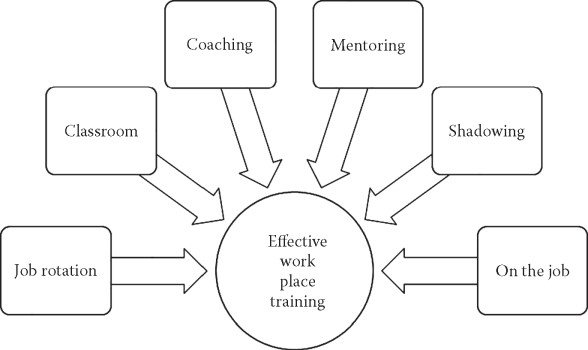
As a trainer when you ask the right set of questions to yourself, you can significantly enhance your training delivery.
Is it okay to offer video training while teaching on-the-job trainers?
Are live workshops really effective?
Answers to all these questions can help you engage your learners, assess their understanding, offer feedback, and stimulate critical thinking. However, as a trainer who has attended a live online master trainer program, you know there are several factors to consider before offering training. Since you have seen other educators, you are sure about what mistakes you should avoid.
3 Types Of Training Program
Depending on the approach to the learning process, all training programs can be divided into three categories.
This is often called self-paced learning as it allows learners to study courses at their own pace. E-learning platforms mostly offer asynchronous learning. They mostly teach with videos and hence there is no real-time communication between the instructor and learners.
In some cases, there are no interactions at all. Some of the most common asynchronous formats are web-based programs, training videos, email courses, podcasts, blogs, wiki pages, and printed workbooks. These learning styles may or may not include assessment and a facilitator who offers guidance, answers questions, and collects feedback.
Before we move on to the other types, do you follow us in social media? If not, do follow us as we regularly share upgraded educational content, tips, feedback and more. Check us out by clicking the profiles here - Facebook / Twitter / LinkedIn / Instagram / YouTube
This is learning that happens when a live educator interacts with students in real-time. Regardless of whether the learners sitting in a four-walled classroom or attending sessions online, the key aspect is that they are being trained simultaneously.
The most common types of synchronous formats include on-the-job training, workshops, traditional classroom training, and live webinars.
When synchronous and asynchronous learning are combined to offer the best of both worlds, it creates blended learning. Here the training is offered both through real-time sessions and pre-recorded videos.
The most common types of blended learning formats include self-paced e-learning courses, live workshops, networking sessions, and on-the-job training.
5 Most Common Types Of Training Delivery Methods

Here are some of the most common training delivery method types:
Research reveals that 54% of the training offered to students in 2017 is live face-to-face instructor-led sessions.
Taking into consideration the rapid growth of virtual reality, mobile technologies, and artificial intelligence, this number might come as surprising. Even though it is surprising half of the training in the world still happens within the classroom.
This is because this method has more benefits than technology can ever beat to date. In-person training also allows you to convey practical experience, make communications in real-time, and allow information to flow both ways. The main issue with classroom training can however be scalability as the effectiveness directly depends on the class, size, personality, and professionalism of the instructor.
These are another type of face-to-face training and the same presentations, lectures, and workshops are conducted but through online platforms. Webinars are flexible and do not require the physical participation of all participants in one location.
Furthermore, they are not only convenient but also a cost-effective way to reach every employee. Learners, however, have limited capacity as they can only use the chat or audio section to share their questions and comments depending on how the host manages them.
E-learning is just a different name for live workshops. There is visual and text content flashed on the screen often accompanied by the voiceover of an instructor. These instructions can also include simulations, video lectures, interactive quizzes, and additional resource materials for further reading.
The latest trends in mobile learning also include activities that are adapted for tablets and smartphones. Such training works best for the ones that don't require immediate feedback from the instructor or live collaboration between learners.
These are low-cost and informal ways of learning. Such training is often conducted in person with the help of a virtual meeting room or it can be in special private chat groups or messengers. If you are trying to provide an additional learning experience, communication, and engagement for your learners, this type of delivery method works best.
These cannot act as a standalone way for delivering training; however, it is a good way to extend the value of self-paced learning programs. In these programs, learners can also discuss what they are learning while helping each other and sharing ideas on how they are preparing.
Training doesn't always have to involve a particular course; it can be professional or personal development training as well. One-job training is one of the best ways through which individuals get hands-on experience and learn by doing.
There usually is no formal instructor and experienced employees conduct these trainings from their new joiners or the company can conduct them for the benefit of their employees. The main issue with these jobs however lies in the availability of the employees and good mentors.
Select The Best Delivery Plan For Your Employees
People and companies are diverse, hence training should also be diverse. It should cater to the needs and developmental goals of every participant present. Thus, choosing the right delivery methods and training techniques can be a long shot. However, there is no hard and fast rule that you will have to stick to any one delivery method. You can mix and match at your convenience and through a series of trials and errors figure out what works best for your employees. To understand their needs better you can enrol for a Live online Master Trainer Program to know the digital sphere better and plan your training appropriately.
We believe education should be accessible for everyone. That’s why we don’t charge for our blogs. Find the right course that will help you in your career with us, contact us at - 9739615888. You can mail us at info@ctpdasia.com
Written By : Victoria Lewis
Centre For Training & Professional Development (CTPD) - The Trading brand of TTA Training Private Limited, India is a ISO 9001:2015 Company




© 2021 - Centre For Training & Professional Development (CTPD). All Rights Reserved. Centre For Training & Professional Development (CTPD) trading brand of TTA Training Pvt. Ltd (India) - CIN U80902WB2016PTC215839, Asia Teachers Training Co., Ltd (Thailand) - Registration No. 0105558193360 & Asian College Of Teachers Ltd (UK) - Company Number 9939942 & Asian College Of Teachers LLC, (USA) - Federal Tax Identification Number 30-1261596
Designed by kreativewebtech